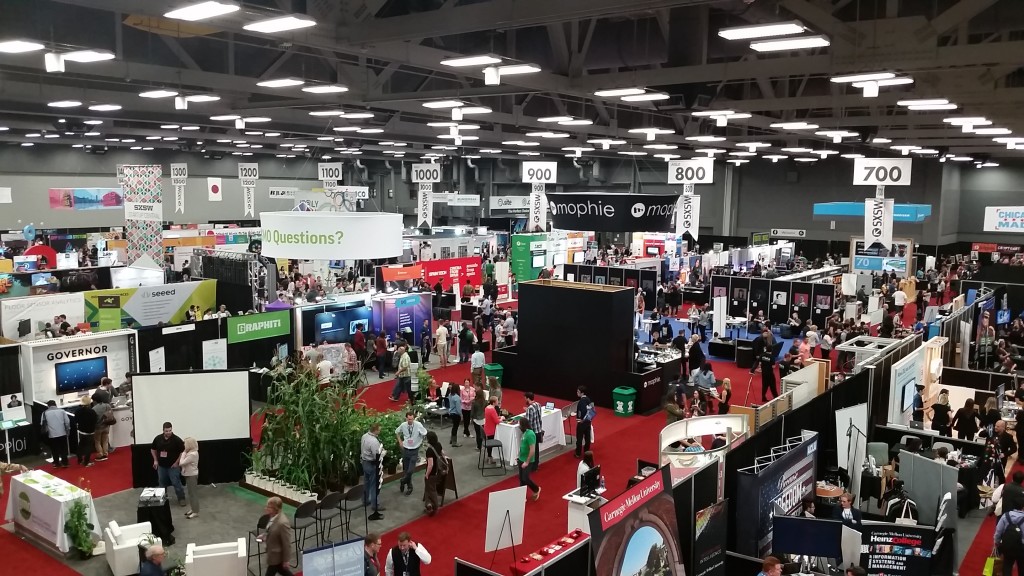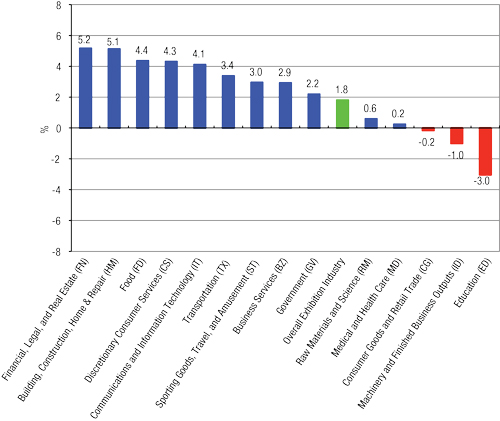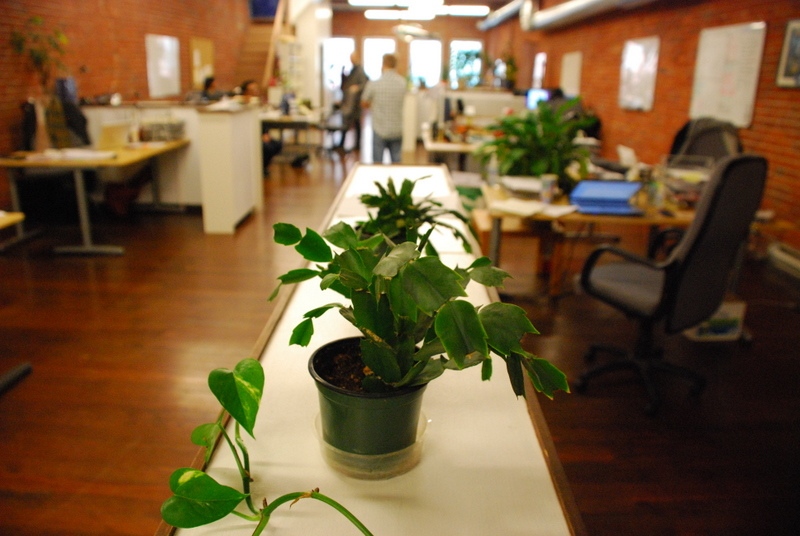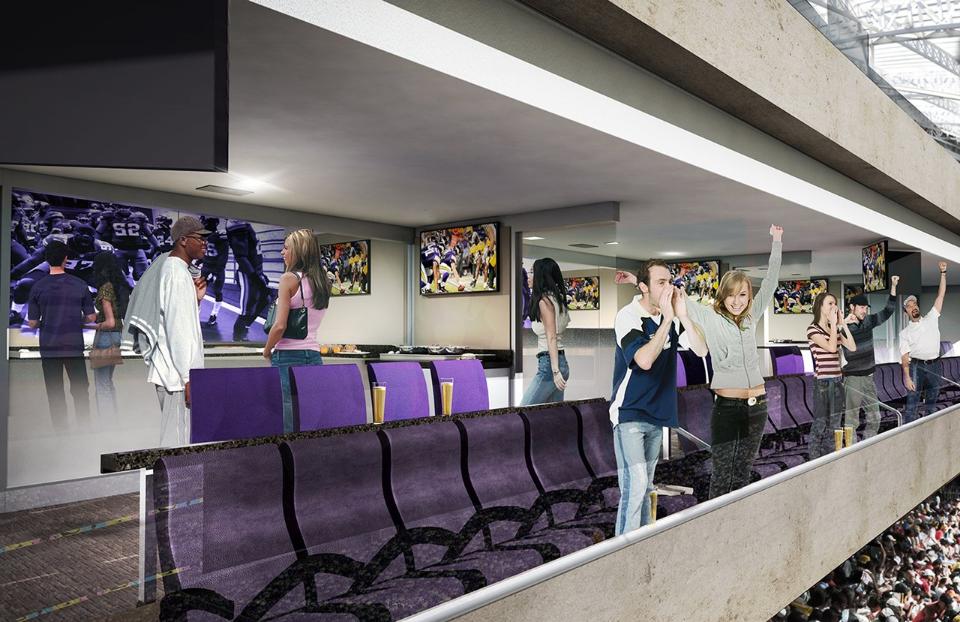Moderate Growth Seen in Exhibition Industry

The Center for Exhibition Industry Research (CEIR) last week released its 2014 CEIR Index Report, which takes a look at the exhibition industry and offers a three-year outlook. The analysis found that the industry grew 1.8 percent for the year as a whole, which is one percentage point higher than 2013 and below the 2 percent forecasted growth.
“The best performing sectors in 2014 were the Financial, Legal and Real Estate and Building, Construction, Home and Repair sectors, which respectively gained 5.2 percent and 5.1 percent,” CEIR’s President and CEO Brian Casey, CEM, said in a statement. “Alternately, the weakest exhibition sector was Education, where the index declined by 3.0 percent.”
The overall industry is expected to grow at a rate of 2.8 percent for 2015.
“We are optimistic for the performance of the industry overall this year,” said CEIR Economist Allen Shaw, PhD, chief economist for Global Economic Consulting Associates Inc. “Economic and job growth should continue to drive expansion in exhibitions.”
The CEIR Index measures year-over-year changes in four key metrics to determine overall performance: net square feet of exhibit space sold, professional attendance, number of exhibiting companies, and gross revenue, and the Index provides data on exhibition industry performance across 14 industry sectors, such as education, sporting goods, and travel and entertainment.
(Bottom Image: CEIR)
Earth Day May Make You Think Twice About That House Plant
Earth Day is this week on April 22, but the single-day theme can definitely be used all month long during April. Often we associate Earth Day activities with being outside in the sun and natural environment, but one topic that has been newsworthy lately are the effects that plants may have on indoor air pollution. Some sources, including NASA, show research that house plants can have a very beneficial effect on indoor air contaminants, and to the point that some even “clean the air.” The EPA is a bit more conservative and states that more research needs to be done, and the most effective way to improve indoor air quality is still through mechanical ventilation and air conditioning systems.
Either way, indoor and outdoor plants are a welcomed sight to our buildings and facilities. Our guests and staff alike seem to “breathe a little calmer” when they are walking in one of our gardens, sitting next to a planter, or working in an office with a plant on their windowsill.
To learn more about this topic, please visit these sites: “9 house plants that clean the air and are hard to kill” and “Can plants control indoor air pollution?”
(Image: Sean Hagen/Creative Commons)
Minnesota Vikings to Add Mini Suites to New Stadium
The Minnesota Vikings plan to build 15 additional suites in the new stadium set to open in 2016.
The new, 10-person suites will be known as the Norseman Lounge Mini-Suites and will replace three of four loge lounges planned in the stadium’s original design. The suites will be available for all Minnesota Sports Facilities Authority events year-round.
“With the tremendous interest we have seen through the first year of suite sales, it became apparent that we should add a smaller, unique seating product,” said Vikings Executive Vice President and Chief Marketing Officer Steve LaCroix in a statement. “We think the Norseman Lounge Mini-Suites will be highly-desired by both individuals and businesses.”
The Vikings’ new stadium will have a total of 131 suites, including the new mini-suites, when it opens. Approximately 70 percent of the total suites have been sold.
(Image: Minnesota Vikings)
IAVM Announces Partnership with Venue and Event Tech Company Sherpa Solutions

Sherpa clients receive valuable data on guest behavior via geolocation technology. Here, exhibit floor traffic is captured to show area density and attendee movement during an event.
IAVM is pleased to announce a 2015-2016 global partnership with Sherpa Solutions. This is the highest partner level available at the association and reflects a tremendous commitment to the community of venues and professionals it serves.
Through the new partnership, attendees to all of IAVM’s conferences and schools will experience Sherpa’s award-winning app platform, including additional venue-wide indoor geolocation features at the VenueConnect Annual Conference & Trade Show (August 1-4, 2015) and at the International Convention Center Conference (ICCC), October 1-3, 2015.
“Sherpa is an innovator in our industry, and their focus on leveraging emerging technologies to improve the guest experience makes them a great partner for IAVM,” said Vicki Hawarden, CMP, president and CEO of IAVM. “Sherpa has been a supportive member for several years, and I look forward to the expanded collaboration that will emerge through this partnership.”
Jacques Racine, founder and chief innovation officer with Sherpa Solutions, shares in the enthusiasm for this new partnership.
“Sherpa is proud to partner with IAVM and contribute to the success of all its events,” Racine said. “We have been attending the ICCC meetings for several years and have always found great value in IAVM. We believe in investing in such an industry leading organization—one that always supports its members.”
Sherpa RTLS Solutions Inc. was founded in 2009 and quickly became a leading developer of mobile applications for the trade show and exhibition industry. With more than 30 staff members, Sherpa is actively involved with over 200 events in six countries. Sherpa counts many of the biggest trade show and conference organizers in the business as clients, including Reed Exhibitions, Emerald, Penton, Diversified, and Informa.
Business Barometer: Business Is Good
VenueDataSource is happy to share with you the latest “Business Barometer,” in which positive trends are evident.
For example, looking at the average ratings during the course of the full 2014 year, most managers indicated that current business conditions are better than the prior year (64 percent), as evidenced by the fact that the majority felt that attendance (54 percent), revenue (61 percent) and the number of events (50 percent) increased. But this improvement came with a cost, as 25 percent reported increasing their full-time head counts, and two-thirds said it increased their full and part-time labor costs.
Perceptions of future business prospects are even more optimistic, with three-quarters of the managers predicting that attendance (72 percent), revenue (75 percent), and business overall (77 percent) will increase.
Business is good and poised to get even better.
Download the latest “Business Barometer” to learn more about business conditions in your sector (e.g., arenas, convention centers, etc.), and visit the VenueDataSource page to stay up-to-date with the latest research that will help make you informed business decisions.
Do you want to receive a Front Row News weekly digest?
Categories
- Allied (861)
- Architecture (147)
- Arenas (747)
- Career (897)
- Convention Centers (895)
- Education (623)
- Events (1,544)
- Food & Beverage (193)
- Foundation (113)
- Guest Experience (1,496)
- Industry News (2,270)
- Leadership (1,888)
- Marketing (150)
- Membership (2,000)
- Music (213)
- Performing Arts Centers (454)
- Professional Development (409)
- Research (127)
- Safety & Security (442)
- Sports (763)
- Stadiums (608)
- Student (159)
- Technology (516)
- Ticketing (92)
- Touring (82)
- Trends (364)
- Uncategorized (725)
- Universities (218)
- Video (25)
- Young Professional (198)
Twitter Feed
- Twitter feed loading
Recent Posts
- McNamara Named General Manager of Will Rogers Memorial Center
- Matt Rife Breaks Record for Most Tickets Sold for a Comedy Show at Honda Center
- The Events Industry Council Recognizes the Miami Beach Convention Center (MBCC) for Achieving Gold Level Sustainability Certification
- Raleigh Convention Center Shares Designs of Upcoming Expansion
- Acrisure Arena Wraps ‘Magnificent 7’ with Record-Setting Week of Live Entertainment, Welcoming Fans from All 50 States
Categories
- Allied
- Architecture
- Arenas
- Career
- Convention Centers
- Education
- Events
- Food & Beverage
- Foundation
- Guest Experience
- Industry News
- Leadership
- Marketing
- Membership
- Music
- Performing Arts Centers
- Professional Development
- Research
- Safety & Security
- Sports
- Stadiums
- Student
- Technology
- Ticketing
- Touring
- Trends
- Uncategorized
- Universities
- Video
- Young Professional
Archives
- November 2025
- October 2025
- September 2025
- August 2025
- July 2025
- June 2025
- May 2025
- April 2025
- March 2025
- February 2025
- January 2025
- December 2024
- November 2024
- October 2024
- September 2024
- August 2024
- July 2024
- June 2024
- May 2024
- April 2024
- March 2024
- February 2024
- January 2024
- December 2023
- November 2023
- October 2023
- September 2023
- August 2023
- July 2023
- June 2023
- May 2023
- April 2023
- March 2023
- February 2023
- January 2023
- December 2022
- November 2022
- October 2022
- September 2022
- August 2022
- July 2022
- June 2022
- May 2022
- April 2022
- March 2022
- February 2022
- January 2022
- December 2021
- November 2021
- October 2021
- September 2021
- August 2021
- July 2021
- June 2021
- May 2021
- April 2021
- March 2021
- February 2021
- January 2021
- December 2020
- November 2020
- October 2020
- September 2020
- August 2020
- July 2020
- June 2020
- May 2020
- April 2020
- March 2020
- February 2020
- January 2020
- December 2019
- November 2019
- October 2019
- September 2019
- August 2019
- July 2019
- June 2019
- May 2019
- April 2019
- March 2019
- February 2019
- January 2019
- December 2018
- November 2018
- October 2018
- September 2018
- August 2018
- July 2018
- June 2018
- May 2018
- April 2018
- March 2018
- February 2018
- January 2018
- December 2017
- November 2017
- October 2017
- September 2017
- August 2017
- July 2017
- June 2017
- May 2017
- April 2017
- March 2017
- February 2017
- January 2017
- December 2016
- November 2016
- October 2016
- September 2016
- August 2016
- July 2016
- June 2016
- May 2016
- April 2016
- March 2016
- February 2016
- January 2016
- December 2015
- November 2015
- October 2015
- September 2015
- August 2015
- July 2015
- June 2015
- May 2015
- April 2015
- March 2015
- February 2015
- January 2015
- December 2014
- November 2014
- October 2014
- September 2014
- August 2014
- July 2014
- June 2014
- May 2014
- April 2014
- March 2014
- February 2014
- January 2014
- December 2013
- November 2013
- October 2013
- September 2013
- August 2013
- July 2013
- June 2013
- May 2013
- April 2013
- March 2013
- February 2013
- January 2013
- May 2012
- March 2012
- December 2011
- November 2011
- October 2011
Recent Comments
- Frank Bradshaw, Ph.D., CVE on John Meyer, CVE, a Tireless Advocate of Certification for Venue Professionals, Has Died
- Neil Sulkes on Hilary Hartung, Friend to Many in Venue Marketing, Has Left Us
- Jason Parker, CVE on The Devastation of Hurricane Helene and How We Can Support One Another
- Larry Perkins on Touhey Testifies Against Speculative Ticketing Before Congressional Subcommittee
- Peter Secord on Major Players for Planned Elkhart Amphitheater Were in the Mix at VenueConnect




